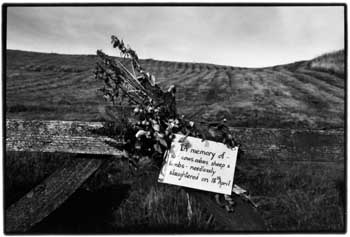| thumbnails |
 |
On
February 19, a vet at an abattoir in Essex noticed blisters round the mouths
of a batch of pigs due for slaughter. An inspector from the Ministry of
Agriculture confirmed everyone's worst fears: Foot and mouth had returned
to the UK. Within a week the disease had spread rapidly across the country.
Six months on, animals at over 2000 farms have tested positive. Besides
culling the infected animals, the authorities have demanded the mass slaughter
of livestock on all neighbouring premises: To date 9,363 farms have lost
3,868,000 animals. The government has come under harsh criticism for not
confronting the disease more seriously. In the run-up to the general election,
Tony Blair announced that the epidemic was over. Since Blair regained his
position as Prime Minister on 7 June, the disease has quietly continued
to plague rural Britain. Meanwhile, public awareness has dimmed as the story
has been given minimum coverage. When a new outbreak struck Northumberland
in late August, the Department of the Environment, Food and Rural Affairs
(DEFRA) did all it could to discourage journalists from reporting. In one
case, a photographer was stripped naked and sprayed with disinfectant after
visiting a farm. "Initially, we had a lot of public support", explains a
farmer. "But now it no longer has media attention, people think its over.
The government is trying to portray that everything's back to normal, but
its as bad now as its ever been". The statistics say it all: In first week
of September, 36,000 more cows and sheep were condemned to slaughter. Hot,
dry conditions destroy the virus, but in a cold, damp atmosphere it can
remain active indefinitely. While the English summer failed to eradicate
foot and mouth, the forthcoming winter offers little hope of recovery. In
total, the crisis has cost the nation an estimated £5.5 billion. And many
more rural businesses, particularly those that rely on agriculture and tourism,
are expected to collapse over the next six months. Even if the virus is
eradicated, it will take at least a year for life to return to normal on
all the affected farms, and an entire generation to restock to former standards.
|
